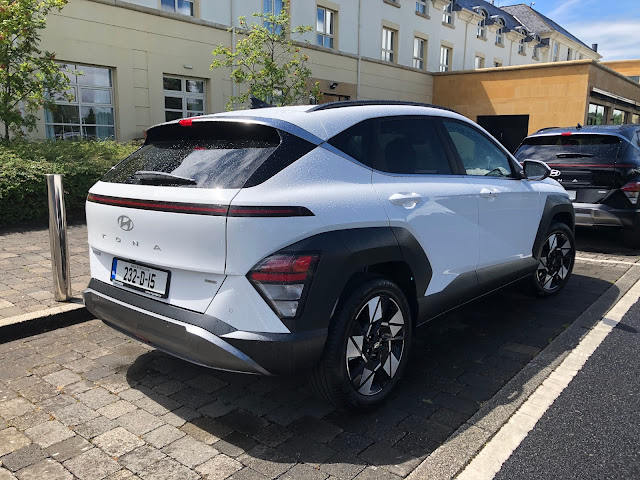Hyundai are on a major roll with their Ionic 5 and Ionic 6 electric cars being awarded World Car of the Year for the last two years and the Ionic 6 recently voted Irish Car of the Year for 2024.
The model has previously sold over 12,000 units since launched in 2018.
New Kona has moved up in size from the previous generation which was a small crossover aimed at families with small kiddies.
The model has now evolved into a more stylish and larger SUV that is wider and longer than before so is aimed at larger families with teens who need more space providing them with more head, shoulder and leg room.
Kona is positioned between the Bayon and the Tucson in the company’s crossover SUV line-up.
The SUV’s sporty character is emphasised by its futuristic front design, rugged wheel arch cladding and high ground clearance. I especially liked the sharp lines at the sides that harmonise with the satin chrome moulding that travels through the belt line to swerve up to the rear spoiler, creating a contour that wraps around the entire car. The rear has a side-to-side light bar that makes the vehicle appear even wider.
The cabin is now more stylish and a lot roomier. Comfy seats hold you in snugly and the driver’s has lumbar support. Front ones can be heated, along with the steering wheel. The dash is dominated by two 12.3-inch digital displays that merge together with beautiful graphics set against a black glass type background. The infotainment screen manages many of the car’s functions and its big suite of safety technology, and of course, Apple CarPlay/Android Auto.
You can change the gauge style of the driver’s screen to suit your own preference: ‘Classic’ with a traditional style two-dial screen or ‘Simple’ that shows your current speed in digital numbers.
The thick stalk gear shift control on my hybrid version was located on the lower right hand side of the steering wheel. Useful storage are a tray area below the front arm rest with adjustable cupholders, a decent glovebox with an overhead open area, and good door bins. You also get a wireless phone charger, 12v power socket and two small C-type USB ports front and rear.
Boot capacity has grown by 30pc and is now at 466 litres. Rear seats fold flat in seconds and you don't have to remove the headrests. When folded, the boot space expands to 1300 litres.
Drive modes are Eco, Sport and Snow.
Buyers have a choice of petrol or hybrid/petrol variants. A full electric version is due this October - no spec or pricing yet.
The entry-level is a 118bhp 1.0 turbocharged petrol unit. The hybrid’s 1.6 GDi direct injection petrol engine and the battery-powered electric motor work together to deliver a combined output of 141hp. The 43hp electric motor delivers high torque of 265Nm and high efficiency and also delivers really good acceleration when starting. It can do 0-100km/h in 10.9 seconds.
Hyundai say their hybrids are well suited to urban owners who experience constant stop/start driving in towns and cities which helps with regenerative braking that charges the battery so you don’t have to. The energy stored in the battery powers the electric motor to help in acceleration, uphill driving, and low speed driving.
A small crib was the absence of any blind spot alert on my car.
I was able to get a really excellent driving position and enjoyed good all-round visibility and good feedback from the steering wheel. Parking assist features were all a great help when parking in tight spots. Hyundai engineers have worked well on road noise reduction resulting in a really quiet cabin.
The engine is mated to a really smooth automatic transmission. For me, it is one of the best around contributing hugely to my driving enjoyment. The car switches seamlessly between its petrol engine and electric motor, but sometimes uses both. I managed to achieve a healthy 5.6L/100kms (50mpg) over a wide mix of roads. Road tax is €180.
Trims are Signature, Elegance (my car), and N Line - the latter is more about looks than features added. New Kona is the first Hyundai to apply the new Connected Navigation Cockpit, and has Bluelink application as standard on all drivetrains. Also standard are LED lights front and rear, 16-inch alloy wheels, black side body moulding, tinted rear windows, a windscreen defog function, auto climate control, rear view camera, front and rear parking sensors, cruise control, a 12.3-inch touchscreen and 4-inch Cluster, a skinny spare wheel, and trailer package.
My Elegance car had stunning 18-inch alloys, power folding mirrors, 12.3-inch touchscreen with Satellite Navigation and Media Centre, a supervision cluster, and black roof rails. Safety features included Hill Start Assist, Downhill Brake Control, Forward Collision-Avoidance Assist, Smart Cruise Control, Auto Hold, and Highway Driving Assistance launched with New Kona.
Kona was awarded a maximum five star safety rating by Euro NCAP when tested in 2017.
Competitors include the Toyota C-HR, Peugeot 2008 and Nissan Juke.
Kona has a 5yr/unlimited kms warranty.
Prices are from €30,895. My review car €36,045.



